Sphinginae subfamily
Sphingini tribe:
 |
Agrius cingulata,
USGS Pink-spotted hawkmoth,
stray
This moth is a very strong flier, but would only make its way to
Atlantic County as a rare stray. There are not too many records from
New York state, but records exist for NJ and CT.
|
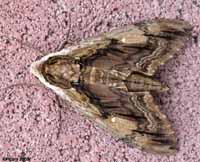 |
Ceratomia amyntor
TH,
the Elm Sphinx or Four-horned Sphinx
The upperside of the forewing is brown with dark brown and white
markings including a white costal area near the
wing base, dark streaks along the veins, and a white spot in the cell.
Larvae feed on Elm (Ulmus), birch (Betula), basswood (Tilia), and
cherry (Prunus). |
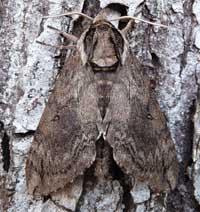 |
The upperside of the forewing is yellowish brown with no white
markings, but there are indistinct black lines and dashes.
The larvae feed in large groups and are much more
spectacular than the moths.
Catalpa is the larval host. |
 |
The upperside of the forewing is pale brownish gray with wavy black
and white lines and a black-outlined white cell spot.
|
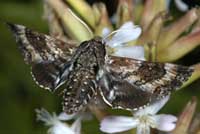 |
The upperside of the forewing is dark brown with a dusting of white
scales. Some moths have patches of reddish or yellowish brown on the
wings.
|
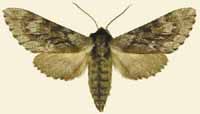 |
The upperside of the forewing is gray with heavy black bands. The
upperside of the hindwing is brownish gray with no markings.
|
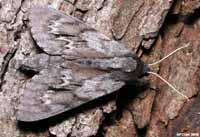 |
The upperside is of the forewing is gray with two (sometimes one or
three) black dashes near the wing center; other markings are usually
diffuse. |
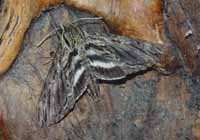 |
This species is not officially reported in Atlantic County.
Generally it is not
widely reported. |
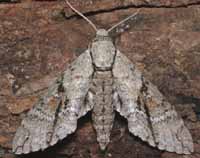 |
This species is not officially recorded in Atlantic County.
It is reported in New Jersey, southeastern New York and Connecticut.
It might be present in Atlantic County.
|
 |
The moth abdomen usually has five but sometimes six pairs of yellow
bands. The upperside of the forewing is blurry brown and gray.
|
 |
The abdomen of the adult moth has three pairs of yellow spots. The
upperside of the forewing is yellowish brown to deep chocolate brown
with a dusting of white scales and zigzagged black and white lines.
|
 |
Manduca sexta
TH/ USGS, the Carolina Sphinx
This species is recorded in Atlantic County.
If you grow tomatoes, you have probably encountered it.
Larvae get very large and can strip a tomato plant.
|
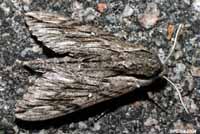 | The upperside of the forewing is gray with indistinct black and
white markings. There is a series of black dashes
from the base to the tip, and a small white cell spot.
|
 |
Sphinx chersis
WO, the Northern Ash Sphinx or Great Ash Sphinx
The upperside of the forewing is soft dark gray to blue-gray with a
series of black dashes, one of which reaches the wing tip. unlikely
|
 |
This species is officially reported in Atlantic County. We have them
on P.E.I., but I do not see them nearly as frequently
as I see the other Sphingidae. |
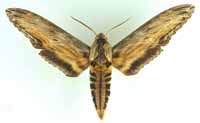 |
This species is not reported in Atlantic County, and generally it is
not widely reported anywhere. Similar to S. kalmiae but lacks the dark bar
along the fw inner margin.
remote possibility |
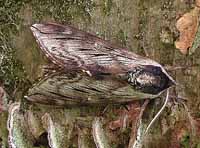 |
This species is reported in Atlantic County. Generally it is
widely reported in neighbouring counties.
Note the pm line, absent in Sphinx poecila which flies
more to the north. |
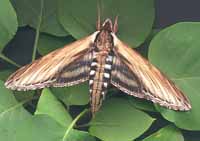 |
The lower forewings are predominantly brownish-yellow with a fairly
wide dark bar along the inner margin. At rest the wings hug the body,
giving the moth a long slender look.
|
Smerinthini Tribe:
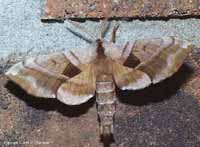 |
The adults are also highly variable; sometimes wings of an individual
may be all one color or may have several colors, ranging from pale
to dark brown, and may have a white or pink tinge.
See the file for the female; she is different. |
 |
Pachysphinx modesta
TH,
the Modest Sphinx or Poplar Sphinx
This moth has a large, heavy body, and females can be remarkably
plump. |
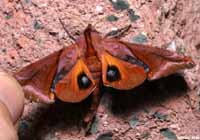 |
Paonias astylus
TH/ USGS, the
Huckleberry Sphinx
This appears to be an uncommon species. They are officially
recorded for Atlantic County, and they are reported for northeastern
New Jersey and Connecticut.
|
 |
Named for the dull grey-blue spot (minus dark pupil) in the hindwing,
this moth has a wide distribution and is probably common in
Atlantic County.
I regularly see them on Prince Edward Island, and they are reported
as far south as Florida. |
 |
Named for the small eye-spot in the hindwing, this moth has a wide
distribution and is probably common in Atlantic County.
I regularly see them on Prince Edward Island, and they are reported
as far south as Florida.
|
 |
This moth is widely distributed and fairly common.
Along the East Coast, it flies from P.E.I. to Florida. likely present
|
Macroglossinae subfamily
Dilophonotini tribe:
See Hemaris comparison to help distinguish
the next three species.
 |
Hemaris thysbe
TH, the Hummingbird Clearwing
It is not difficult to see why many gardeners would mistake an
Hemaris thysbe moth for a small hummingbird as it hovers,
sipping nectar from flowers through a long feeding tube.
|
 |
Hemaris diffinis
TH, the
Snowberry Clearwing or Bumblebee Moth
Adults mimic bumblebees and are quite variable, both geographically
and seasonally. The wings are basically clear, with dark brown to
brownish-orange veins, bases and edges.
|
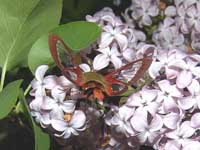 |
Hemaris gracilis
TH, the
Slender Clearwing or Graceful Clearwing
Hemaris gracilis is distinguished from similar species by a pair of
red-brown bands on the undersides of the thorax, which varies from
green to yellow-green dorsally and sometimes brown with white
underneath.
|
Philampelini tribe:
 |
Adults nectar from flowers of Japanese honeysuckle
(Lonicera japonica), petunia (Petunia hybrida), mock
orange (Philadelphus coronarius), and phlox (Phlox).
Note the differences between this moth and the Pandorus Sphinx. |
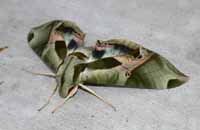 |
If you have Grape or Virginia Creeper nearby, then you probably have
this species.
I often get asked to identify larvae from areas not
previously reported. |
Macroglossini tribe:
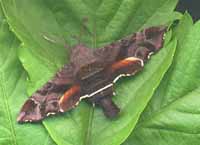 |
This day flier is widely distributed. If you have Virginia Creeper, you
probably have the Nessus Sphinx. It is reported from
Atlantic County by Tom Hupf.
Two bright, distinct, narrow yellow
bands are often visible on the abdomen.
|
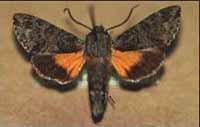 |
This species is rarely recorded in the U.S., but there are sightings
in the east from Florida, South Carolina, New Jersey, New York,
Massachusetts and
New Hampshire.
There are reports from nearby Cape May County.
|
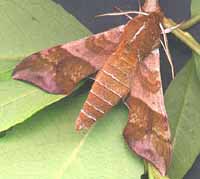 |
They are common in New Jersey and common
here on Prince Edward Island.
You will often see this species listed as Darapsa pholus,
especially in older literature.
It is confirmed for Atlantic County. |
 |
Darapsa myron
TH, the Virginia Creeper Sphinx or the Grapevine Sphinx
This moth is not recorded on the U.S.G.S. site for Atlantic County
It is widely reported as far north as southern Maine. If you have the
foodplants indicated in the common names, you probably have this
species nearby. |
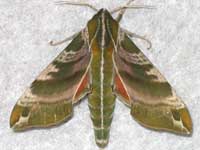 |
If you have hydrangea growing near a stream, then you may have the
Hydrangea Sphinx. Tom Hupf reports it in Atlantic County.
|
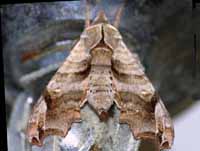 |
The moth's outer margin of the forewing is deeply scalloped.
The upperside is light brown with dark brown markings.
There is a small black and white spot near the tip.
The upperside of the hindwing is orange-brown with a dark brown
outer margin and median line.
|
 |
Hyles lineata
TH, the White-lined Sphinx
The forewing upperside is dark olive brown with paler brown along the
costa and outer margin, a narrow tan band running from the wing tip
to the base, and white streaks along the veins. |
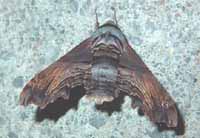 |
This moth is very much under reported across the United States. It
is a rapid day flier so is probably not in too many collections.
Grape is a popular larval host. It is confirmed in Atlantic
County by Tom Hupf.
|
 |
This moth is much more common to the south. It is a strong migrant,
however, and may establish itself in Atlantic County periodically.
|
|
|


